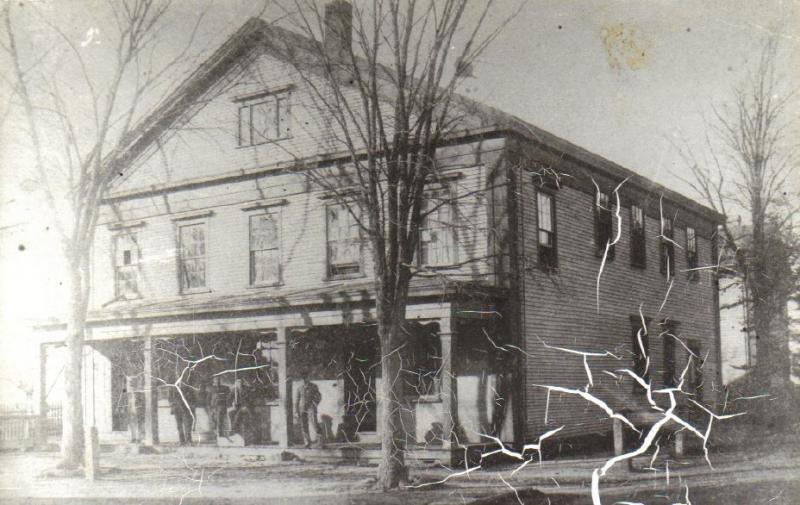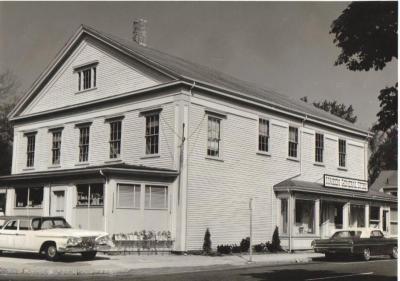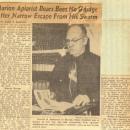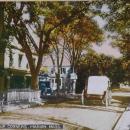The Marion General Store: A village time capsule
MARION — The Marion General Store started its life as a church.
In the 220 years of its existence, the store has not only been in the center of Marion’s downtown, it’s also been the center of the town spiritually, and a community hub even after it changed to a retail operation. Now, the current owner Jack Cheney and the Sippican Historical Society are making sure this historic building is in good shape.
Even the building’s parking lot has history, as it used to be the house of one of the earliest owners before it was torn down to make space for the lot.
Construction of a new Congregational Church in 1794 marked an important step in Marion’s history and independence from Rochester, as it meant that people no longer had to travel to Rochester for church.
The building was completed in 1799 and was used as a church for forty one years. The painted ceilings from the church still remain in the building’s second floor and as the renovations do not touch the second floor.
For the first century of its existence, the building served not only as a church, but also as a place for many other public affairs. The second floor of the building held plays and Town Meetings. Period documents refer to the building as being able to hold “several hundred people.”
The first owner of the building as a store was Stephen Delano (of no relation to Franklin Delano Roosevelt, though the president did have ancestors in Massachusetts). When Delano sold it to Andrew Hadley, he did so for only $1,000. Delano significantly changed the interior of the building, which was at that point known as “Delano’s Hall”
Additions to the building’s east and south sides, made around the 1950s, have also changed its appearance from when it was a church.
The store was owned over the years by Delano, Hadley, Peter Hadley, William R. Luce, Fred Cobb and Charles Hathaway. His son, Alonzo Hathaway, took over the business before it passed to its current owner, Jack Cheney.
On Dec. 14, 1927, when the store was owned by Cobb and Hathaway, it experienced a dramatic robbery. A neighbor watched from her window across the street as robbers stole $300 worth of goods in the middle of the night.
“According to Mrs. Tripp, she was so excited that she did not think of calling her husband until it was too late to stop the robbery,” a newspaper account from the time reads.
Charles Hathaway also appeared in the paper as a beekeeper who researched the history of bees, escaped being almost stung to death, and worked on a cure for the much-feared “foul brood,” which causes hives to rot.
His son Alonzo, the article mentions, was sailing with United Fruit Company when World War II started and his ship was commandeered by the U.S. Government as part of the Merchant Marine.
Ann Hathaway, Alonzo’s daughter, now lives in Marion again, though she was living in Boston at the time that her mother sold the store to Cheney.
“My fondest memory of the store had to do with the large floor heat register in the store. I used to love to go in and stand on top of the register, and it would blow my skirt and petticoat up,” Ann said.
Ann said that the way the store looks has not changed since her grandfather’s time. But she recalls products her father used to sell, like fancy holiday baskets from the now defunct SS Pierce, and notes that “that era is gone,” adding that, “Jack was always willing to bring in new goods.”
Cheney, is not a Marion native, and grew up on ranch in Montana before his family moved when he was 10 because of grandparents’ store in Wareham.
His first experience with the store was “from when I was a young man, when somebody else owned it,” Cheney said.
Though it wasn’t part of his early memories, or even his first business, Cheney has adopted the Marion community as his own.
“I went to college and got my marketing degree, and when businesses came around to interview I forgot to go. Well, I didn’t forget, but I didn’t go because I knew in my heart that I never wanted to work for anyone else,” Cheney says.
Talk to Jonathan Henry, a lifelong Marion resident currently serving as the interim head of the Department of Public Works, and he can sketch out what the store has meant to the town.
“It was in business when I was little and long before that and it was owned by the Hathaways,” Henry said.
“Kids could hang around there and it was a friendly warming place,” recounted Henry, “Everyone who worked there took care of their customers. They knew your name, your mother’s name. And the building looks more or less how it looks now.”
Running it “was a family affair and the people who worked there were from families right in the area,” Henry explained.
He has vivid memories of specific employees, recalling the butcher, Jessie Clouter, in “what you’d call an old fashioned butcher’s outfit, with straw hat and armbands on the sleeves,” the two Tripp siblings, both of who dedicated their careers to the store, or the delivery man, Hal Dorr, who lived on the corner of Main and School Streets.
Most of the customers, too, were locals.
“Most of the local people lived and worked in town,” Henry said. “People walked home from where they were working they would stop into the General Store and pick up something.”
Though the store also had another function, as it “catered to people from boats who would come ashore to buy food and the summer people would all have accounts,” Henry said.
The store’s location and the relationships between the owners and Marion residents made the store a centerpoint of town life.
“As much as a church it was what contributed to the life of the town,” Henry said, adding that even now, “I don’t know what we would do without it. It’s an anchor.”
“It’s got to be one of the oldest general stores in existence. A guy who was an authority on general stores came to give a lecture about them, but that one [the Marion General Store] would have been older by a long-shot than many he was talking about,” Henry said.
It’s not just the town’s history that’s intertwined with the Marion General Store, but also Henry’s family history.
“I lived on 49 South Street for 20 years. That’s where I raised my kids They were in and out of the General store, just like I was,” Henry said.
Renovation and Preservation of the General Store
The Marion General Store will be closed for February and March as the building is modernized. The layout and feel of the store will not change, but a handicap ramp and handicap access bathroom will be added. The general store will get new roofs, insulation, siding, new windows and new wiring.
Asked why he considered renovations now, Jack Cheney answered that the store “just really needed it. Structurally it needed a little help, and once I decided to move forward with that the Historical Society got involved.”
The Sippican Historical Society devotes part of its funds and efforts to restoring buildings, and has done similar restoration projects on the Post Office, Kate’s Simple Eats, and the Hadley House.
“We were afraid because some contractors have come into town and said ‘it’s cheaper to tear it down and build a new one, so this happened to two or three really old buildings in town,” explained Judy Rosbe, member of the Sippican Historical Society. “We said ‘okay, we’ve got to do something about the General Store, because it was built in the 1700s, it’s one of the most prominent buildings in town, and we want to help preserve it.”
Once the Historical Society decided to get involved, Hans Ziegler and David Croll carried out much of the fundraising. “It really impressed me, there was such a positive outpouring from the community to back that project, ” said Francis McNamee, the president of the Sippican Historical Society. He notes that the fundraising still continues even as construction has started. McNamee prefers not to say how much the renovations cost, but notes that the price has “considerably elevated” as a result of additional problems with the windowsills discovered during construction.
While the historical society looks to preserve buildings, had to figure out a way to do that without owning the buildings long-term.
“We really don’t want to be in the business of real estate management, because we’re all volunteers, so we [sell buildings] with a preservation restriction, and I consider [those] buildings saved,” McNamee said.
With the terms of the preservation restriction, “They can never move the building, they can never change the outside, if it burns down they have to rebuild it exactly as it was built,” Rosbe said.
The preservation restriction also affects what kind of stores can inhabit restored buildings as well.
“We wanted to make sure that it stayed for retail. We didn’t want it to be another real estate office because they don’t bring people in, and we wanted the downtown to draw people in,” Rosbe explained.
Though it’s a lot of work to put into one building, McNamee explains that in the case of the General Store there’s a good cause.
“Its really the heart and soul of the village, and a time capsule,” said McNamee
That said, it’s not surprising that many current and former Marion people are doing the renovation work.
Cheney’s daughter, Whitney Wynne has helped with reorganizing the store in preparation for the work. Will Saltonstall, a lifelong Marion resident, is donating his architectural expertise. Longtime Marion resident Lars Olson is the general contractor for the project. And the electrician for the project, Marc Farrell, is doubly involved as a Marion resident and Sippican Historical Society member.
Wynne explained that in renovating, they have kept the building’s historical frame intact, but also added new touches that incorporate the history of some of its owners. One touch is adding Betty’s Corner, a seat in memory of her mother, who passed away in 2007. The store hopes to re–open in April and will throw a re-opening party in June.























